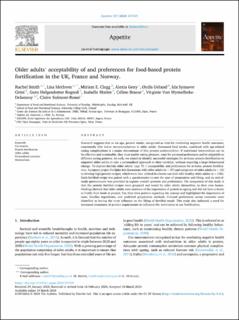| dc.contributor.author | Smith, Rachel | |
| dc.contributor.author | Methven, Lisa | |
| dc.contributor.author | Clegg, Miriam E. | |
| dc.contributor.author | Geny, Alexia | |
| dc.contributor.author | Ueland, Øydis | |
| dc.contributor.author | Grini, Ida Synnøve Bårvåg | |
| dc.contributor.author | Rognså, Guro Helgesdotter | |
| dc.contributor.author | Maitre, Isabelle | |
| dc.contributor.author | Brasse, Céline | |
| dc.contributor.author | Van Wymelbeke-Delannoy, Virginie | |
| dc.contributor.author | Sulmont-Rossé, Claire | |
| dc.date.accessioned | 2024-04-05T12:56:34Z | |
| dc.date.available | 2024-04-05T12:56:34Z | |
| dc.date.created | 2024-03-25T09:06:15Z | |
| dc.date.issued | 2024 | |
| dc.identifier.citation | Appetite. 2024, 1-49. | |
| dc.identifier.issn | 0195-6663 | |
| dc.identifier.uri | https://hdl.handle.net/11250/3125126 | |
| dc.description.abstract | Research suggests that as we age, protein intake, recognised as vital for combating negative health outcomes, consistently falls below recommendations in older adults. Decreased food intake, combined with age-related eating complications is a major determinant of this protein undernutrition. If nutritional interventions are to be effective and sustainable, they must enable eating pleasure, cater for personal preferences and be adaptable to different eating patterns. As such, we aimed to identify successful strategies for at-home protein-fortification to empower older adults to take a personalised approach to their nutrition, without requiring a large behavioural change. To explore healthy older adults’ (age 70+) acceptability and preferences for at-home protein fortification, European project Fortiphy led discussions with older adults (n = 37) and caregivers of older adults (n = 15) to develop high-protein recipes, which were then utilised in a home-use trial with healthy older adults (n = 158). Each fortified recipe was paired with a questionnaire to rate the ease of preparation and liking, and an end-of-study questionnaire was provided to capture overall opinions and preferences. The uniqueness of this study is that the protein fortified recipes were prepared and tested by older adults themselves, in their own homes. Findings showed that older adults were unaware of the importance of protein in ageing and did not have a desire to fortify their foods at present. Yet, they were positive regarding the concept and highlighted the importance of taste, familiar ingredients, and preferred preparation methods. Cultural preferences across countries were identified as having the most influence on the liking of fortified meals. This study also indicated a need for increased awareness of protein requirements to influence the motivation to use fortification. | |
| dc.language.iso | eng | |
| dc.title | Older adults' acceptability of and preferences for food-based protein fortification in the UK, France and Norway | |
| dc.title.alternative | Older adults' acceptability of and preferences for food-based protein fortification in the UK, France and Norway | |
| dc.type | Peer reviewed | |
| dc.type | Journal article | |
| dc.description.version | publishedVersion | |
| dc.source.pagenumber | 1-49 | |
| dc.source.journal | Appetite | |
| dc.identifier.doi | 10.1016/j.appet.2024.107319 | |
| dc.identifier.cristin | 2257102 | |
| dc.relation.project | Norges forskningsråd: 321819 | |
| dc.relation.project | Nofima AS: 13274 | |
| cristin.ispublished | false | |
| cristin.fulltext | original | |
| cristin.qualitycode | 1 | |
